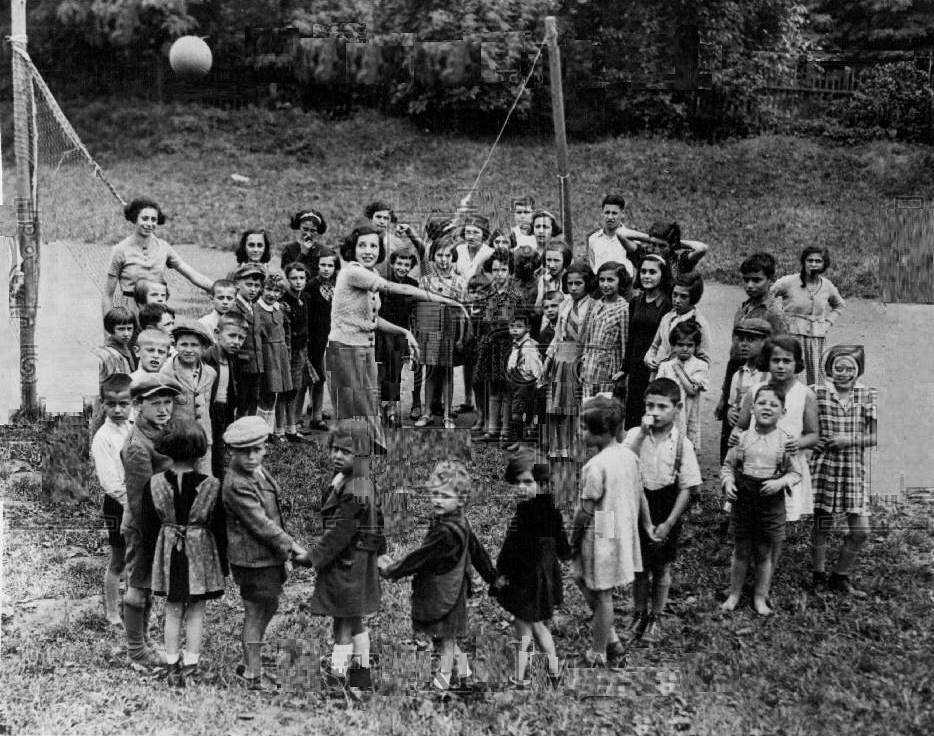
The Holocaust: Czechoslovakia--Refugees (1933-39)

Figure 1.--Here we see Austrian and German Jewish children in Czechoslovakia just before Munich. The date is obscured, but looks to be August 28, 1938. This is one of several wire service photograph with his heading, "Czechoslovakia provides haven at Bruenn: Men women and children without a country. Such are the political refugees from Austria and Germany who have fled from the vegence of the NAZI sastica to the friendky haven established for them at Bruenn, Czechoslovakia. This series of pictures illustrates various phases in the lives of these persons. A taste of normal plsy Top), is given to children of refugees who hve found their way to Burenn. Its all for one and one for all at the camp. A group of men an women (second from top)peel potatoes for dinner. The result is a healthful and filling meal (third from top) as mnembers of the refugee camp sit down for dinner.A touching picture (below) is thsat of a formerly wealthy businessman, now impoverished, as he tells his story in an interview," Note how poorly understood the NAZIs are even as late as938. These are not 'poluitical' refufgees, but Jews. Tragucally few of these children would survive the Holocaust unless they were selected for the subsequent Kindertransport.
|
|
Czechoslovakia was a democratic state, but with strong under currents of anti-Semitism, especially among Catholic parties and the German population in the Sudetenland. This was to a substantial degree held into check by the democratic laws enacted. With the NAZI seizure of power in Germany (1933), Jews began to flee to neigboring countries, including Czechoslovkia. This varied over time as NAZI anti-Semetic campaigns varied. Some Jews believed thst there was still hope to coexust with the NAZIs. This changed when the Nuremberg Decrees stripped Jews of their citizenship. We are not sure to what extent the Czech Government permitted Jews to enter the country. We do not know if there were quotas or to what extentJews crossed the border illegally. This was presumably dangerous if they were caught by NAZI authorities. It was also difficult for families with children or eldely parents. We know of no Czech program to assist refugees, although our information is limited. Not all the refugees were Jewish, there were also political refugees. The largest number by fr, hower, were Jews. Czech Jewish organizations made an effort to assist the refugees. Even more Jewish refugees flowed into Czechoslovakia after the Austrian Anschluss (April 1938). Austrian Jews had few options as the Hungarian, Italian, and Swiss borders were basically closed. Some were refused entry, but we do not yet have a good fix on the actual numbers or Czech immigration poliy. And this substantially increased the length of the border with NAZI Germany. We donnot yet have an accurate count of the total numbers of refugees. The refugee problem increased after Munich and the German seizure of the Sudetenlnd (November 1938). This brought another 15,000–20,000 Jewish refugees into Czechoslovakia. (There were also 140,000 Czech and German refugees.) The German pressure did not stop at the Sudetenland. The Germans forced Czechoslovakia to cede southern Slovakia which was climed by Hungary (November 1938). Slovak officials ordered all foreign and poor Jews from the Slovak side of the new border to move to the area ceded to Hungary. The Hungarians refused to allow some to enter. everal hundred ended up in camps set up on border, Eventually Slovak citizens were allowed to return. Czechoslovak anti-SEmitism was fueled by the NAZI actions and the break diwn of the democratic legal system, especially in Slovakia. This was to a degree moderated by British–French financial grant offered as a sop after deserting Czecoslovakia at Munich. Some of the funds were to be used to assist the Jewish refugees. The final wave of refugees came with Kristallnacht (November 1938), but by this time it was becoming very difficult to leave the Reich.
HBC

Navigate the Boys' Historical Clothing Web Site:
[Return to the Main Czechoslovakian Holocaust country page]
[Return to the Main Holocaust country page]
[Return to Main Czechollovakian World War II page]
[Introduction]
[Activities]
[Biographies]
[Chronology]
[Clothing styles]
[Countries]
[Bibliographies]
[Contributions]
[FAQs]
[Glossaries]
[Images]
[Links]
[Registration]
[Tools]
[Boys' Clothing Home]
Created: 9:12 AM 8/22/2012
Last updated: 9:12 AM 8/22/2012



